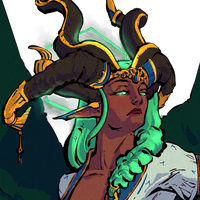Menes'ha Fashion
The Northern Dividing Archipelago
During winter, two layers of clothes are worn. The inner layer has fur inwards, while the fur on the outer layer is turned outwards. This traps air between the layers and provides excellent insulation. Some use sea mammal guts for lighter clothing, but they wear down faster than fur coats.
Garments for people regularly moving between warm homes and freezing outdoors are created with quick and easy removal in mind.
Northern menes’has wear thigh-high fur boots with trousers tucked inside. The outer layer is waterproof and made of skin taken from reindeer legs.
Vivid threads adorn the clothing. Yellow, red and blue are the most common colours. The dyes are made from different barks, roots and berries.
The ornaments are usually geometric, using coloured threads and fur. Nobles decorate coats with imported precious gems and metal beads.
The Southern Dividing Archipelago
Most Southern Divider islands are considerably warmer than their northern neighbour, allowing for lighter clothing. Wool, cotton and leather are commonly used materials, while more expensive linen and silk are frequent in nobility.A tunic and a shawl are the most common garments. They are worn together or separately. The tunic sleeves can be short, elbow or wrist-length. Most living in warmer regions wear sleeveless tops with open backs.
Upper garments are usually tied behind the neck and waist using buttons or metal clasps. Golden necklace collars are a sign of wealth.
The shawls and skirts often have decorative fringes. The trousers are tucked inside boots to not cause drag in the air. Skirts and dresses have thin trousers underneath for a comfortable flight.
Ornaments are usually based on local plants, but more geometric shapes can be seen in certain regions. Phas’qhunj riders frequently add their mount’s feathers to the clothing. Expensive garments are often adorned with golden-threaded embroidery and exotic dyes from Chiraki Abyss or Nikophsia.
Accessories
Nobility accessories are handcrafted from gold, tailored to match the shape of the horns. Precious gems are added to the intricate jewellery. Those with broken horns frequently hide the defects with metal sheathes.
Large earrings and ear covers are popular with the rich. Metal accessories in the Northern Divider are usually lined with leather to not damage skin.















I like how you highlighted the differences between rich and poor and the cold north and the warm south, and that you thought about the little details like how clothes work when flying, how to tuck the big wings, or how to hide broken horns. Very inspiring and of course beautiful as always, great art.
Thank you! It means a lot!